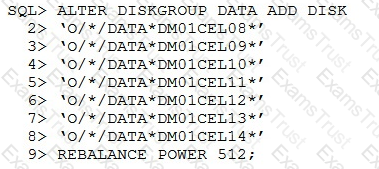Which two options can be used to identify a damaged or failing flash card on an X9M-2 Database Machine High Capacity storage server?
You have been asked to design a backup solution for an Exadata X9M-2 Quarter Rack with Extreme Flash Storage Servers connected to a new ZFS Storage Appliance ZS7 with 2 Storage Controllers with 100Gb Ethernet cards and 3 Storage Trays. You are using Oracle Exadata Configuration Assistant to validate the rack layout.
1. Use "Add Equipment" to add the Exadata X9M EF Storage Servers, starting from RU10.
2. Use drop down to add ZFS Storage Appliance Controllers.
3. You cannot add ZFS Storage Appliance to an Exadata Rack.
4. Use "Add Equipment" to add the ZFS Storage Trays, starting from RU1.
5. Use drop down to add ZFS Storage Trays.
6. Use "Add Equipment" to add the Exadata X9M Database Servers, starting from RU16.
7. Use "Add Equipment" to add the Exadata X9M EF Storage Servers, starting from RU1.
8. Use drop down to add Exadata X9M EF Storage Servers.
9. Use "Add Equipment" to add the ZFS Storage Controllers, starting from RU27.
10. Use drop down to add Exadata X9M Database Servers.
11. Use "Add Equipment" to add the ZFS Storage Trays, starting from RU31.
Which of these steps are correct and what is their correct order?
Which statement is true about the Persistent Memory Commit Accelerator?
You are in the process of upgrading your nonvirtualized X9M-2 Database Machine elastic configuration with 4 database servers and 7 HC storage servers with an additional 4 database servers and 7 HC storage servers.
The new storage servers are called DM01CEL08 through dmoicel14.
After creating 96 new griddisks, you issued this SQL statement:

How many failgroups if any, will be added to the DATE diskgroup by executing this SQL statement?
You want to monitor how a large production table is accessed. Especially, you are interested to see how the access on that particular table leverages the benefits of the Exadata Platform.
Which two actions are NOT appropriate for that purpose?
Which two options describe the flash memory capabilities of the Exadata X9M-2 database and storage severs?
How is Exadata Secure RDMA Fabric isolation used in X9M-2 with virtualization enabled?
You have been asked to investigate why an Exadata Database Server stopped communicating on the client network for 10 minutes over the past weekend.
Which command would help investigate this?
Which two steps concise the path used to communicate with Enterprise Manager from an Exadata Database Machine?
Which two statements are true about enabling write-back flash cache?
Which two statements are true about Auto Service Request (ASR) with an Exadata Database Machine?
Which of the following is NOT a requirement when validating, receiving, unpacking, and planning access route and space requirements for Exadata Database Machine?
You are working on a remote Exadata Database Machine with current software and firmware. You now need to start a storage server after hardware maintenance.
Which ILOM command starts the storage server?
Which two statements are true about Exadata System Software metrics and alerts on an Exadata Database Machine?
Which two of the following network connection types can be deployed on the client network ports of an Exadata X9M-2 Database Server?
Your customer needs to ensure that their data is available on the Exadata machine during updates. The customer wants to be able to update one server at a time but still be protected against single-node server failure.
What ASM redundancy level should they use?
Which two statements are correct about adding an additional database server to a physical Exadata X9M Database Machine using Oracle Exadata Deployment Assistant (OEDA)?
You are planning the monitoring configuration for your Exadata X9M Database Machine.
Which three components are monitored directly through the use of Exadata-specific Enterprise Manager Plug-Ins?
You are monitoring PMEM cache to see if it is being used effectively with RDMA. Which two of these sources contain information about the RDMA I/O statistics?
Which two statements are true for the Oracle Exadata Configuration Assistant (OECA)?
Which two statements are false about backup to ZFS Storage Appliance (ZFSSA)?
Which three statements are true concerning the configuration or use of Enterprise Manager Cloud Control to monitor and manage Exadata Database Machine components?
Which statement is FALSE about the OEDA command line interface (OEDACU)?
You are concerned about the operating temperature of the database servers in your Exadata Full Rack and want to be alerted if the server exceeds 30C.
What command should use use to generate alerts for such an event?
What type of SRs does the ASR Manager generate for Exadata?